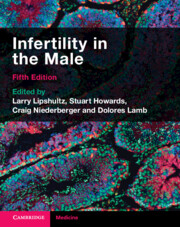Book contents
- Infertility in the Male
- Infertility in the Male
- Copyright page
- Contents
- Contributors
- Foreword
- Abbreviations
- Introduction
- Section 1 Scientific Foundations of Male Infertility
- Section 2 Clinical Evaluation of the Infertile Male
- Section 3 Laboratory Diagnosis of Male Infertility
- Chapter 17 Laboratory Evaluation of the Infertile Male
- Chapter 18 Advanced Diagnostic Approaches to Male Infertility
- Chapter 19 Evaluating Defects in Sperm Function
- Chapter 20 Cryopreservation of Sperm – History and Current Practice
- Section 4 Treatment of Male Infertility
- Section 5 Health Care Systems and Culture
- Index
- References
Chapter 17 - Laboratory Evaluation of the Infertile Male
from Section 3 - Laboratory Diagnosis of Male Infertility
Published online by Cambridge University Press: 08 July 2023
- Infertility in the Male
- Infertility in the Male
- Copyright page
- Contents
- Contributors
- Foreword
- Abbreviations
- Introduction
- Section 1 Scientific Foundations of Male Infertility
- Section 2 Clinical Evaluation of the Infertile Male
- Section 3 Laboratory Diagnosis of Male Infertility
- Chapter 17 Laboratory Evaluation of the Infertile Male
- Chapter 18 Advanced Diagnostic Approaches to Male Infertility
- Chapter 19 Evaluating Defects in Sperm Function
- Chapter 20 Cryopreservation of Sperm – History and Current Practice
- Section 4 Treatment of Male Infertility
- Section 5 Health Care Systems and Culture
- Index
- References
Summary
Sperm are critical for fertility. Thus, a properly collected semen analysis is the keystone of the laboratory evaluation of the infertile male. Combined with the history and physical examination, semen analysis can suggest an etiology for infertility and direct the clinician towards further evaluation and treatment options. This chapter will discuss the components of the standard semen analysis and their interpretation, as well as commonly ordered adjunct semen, hormonal, and genetic testing.
- Type
- Chapter
- Information
- Infertility in the Male , pp. 329 - 347Publisher: Cambridge University PressPrint publication year: 2023



